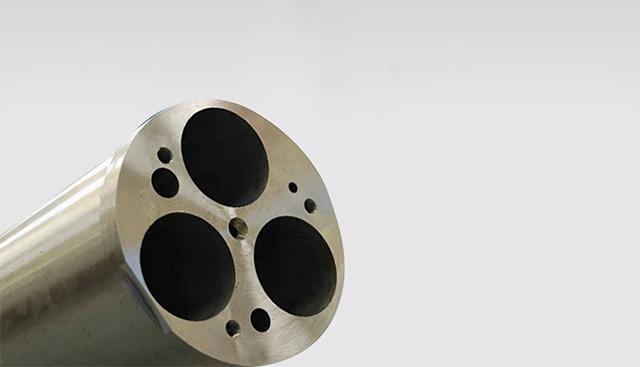In carbide production, you will often encounter requirements that require deep hole machining. Today, Sidi will introduce you to three common methods of machining deep-hole precision parts so that you can learn how to carry out deep-hole machining.

In the deep hole workpiece for precision parts processing, due to the shank is limited by the hole diameter and hole depth, which requires the shank to be slender, but the slender shank will cause its poor rigidity, easy to produce vibration and let the tool phenomenon when turning; due to the hole depth, the drilling process, the drill bit is easy to lead deflection and lead to hole axis skew; due to the hole depth, chip is not easy to exclude, cutting fluid is difficult to effectively cool to the cutting area, and the tool in the deep hole Cutting, tool wear and damage to the tool body are not observable, making it difficult to control the quality of machining.
We commonly have three ways of deep hole machining.
- Gun hole drilling and external chip removal
When processing small diameter deep holes in precision parts, the gun hole drill is generally used. The gun hole drill is made of high speed steel or carbide tip welded to a seamless steel shank. The shank is pressed with a V-groove as a channel for the discharge of chips. The waist-shaped hole is the exit point for the cutting fluid.
- High-pressure internal chip drill
The high-pressure internal chip removal drill consists of a high-pressure, high-flow cutting fluid entering the cutting area from the sealing head through the gap between the deep hole drill and the hole wall, and the chips are discharged from the middle of the chip removal jacket under the flushing of the high-pressure cutting fluid. In this way, as there is no pressure difference within the chip removal jacket rod, a higher pressure (generally 1~3MPa) of cutting fluid is required to discharge the chips from the cutting area through the inner hole of the chip removal jacket rod.
- Spray-suction drilling and internal chip evacuation
The cutting edges of the spray-absorbing drill shape are staggered on both sides of the drill for precision parts machining, and there are small holes for spraying cutting fluid in the neck and two horn-shaped holes in the front end. The chips are flushed from these two horn-shaped holes and sucked out of the hollow tool bar to the outside under the pressure of the high-pressure cutting fluid sprayed from the small holes.
Ltd. specialises in the research and development and precision manufacturing of various high-end wear-resistant components, and its business strategy is to provide customers with solutions for key components required for various types of severe working conditions, such as high temperature resistance, wear resistance, stamping resistance and corrosion resistance, which are widely used in petroleum, chemical, coal, smelting, aviation, engineering equipment manufacturing and other industrial fields. We have more than 300 sets of advanced R&D, production, inspection and testing equipment such as turning and milling centres, five-axis machining centres, four-axis vertical machining centres, CNC horizontal boring and milling machines, Taiwan all-round CNC lathes, deep hole drilling and boring (honing) processing and three-seater gundrilling and ZEISS ACCURA three-seater, etc. We have formed a long-axis casing machine that can process parts with diameters ≤ 400mm and lengths ≤ 3000mm. We have the ability to machine complex structural parts with a diameter of ≤ 400mm and a length of ≤ 3000mm. We have rich experience and super strength in deep hole machining, welcome your attention.












